So for my ongoing review, I’ll try to insert whatever I’ve found in this new build. I’ve got the chance to get a PlayBook for cheap this thanksgiving thanks to Bestbuy. Actually I’m lucky enough to get two HP Touchpads and one PlayBook on sale this year. And here is the review and sort of comparison between the two ill-fated devices. Quick spec first: Height 5.1" / 130mm 7" LCD display, 1024 x 600 screen resolution 1 GHz TI OMAP 4430 dual-core processor (Dual Core Cortex-A9 CPU clocked at 1Ghz + a PowerVR SGX540 GPU) Dual HD Cameras (3MP and 5MP in the front and back, respectively), dual microphones for stereo recording 1080p HD video; H.264, MPEG4, WMV HDMI video output Full Adobe® Flash® 10.1 enabled Wi-Fi 802.11 a/b/g/n NO SD card expansion slot. The build quality is very decent, it’s not thin, but the entire device feels very solid in hand. The 7in 16:9 screen is pretty narrow after coming from a Touchpad which has a 4:3 aspect ratio. (well, technically it’s not a perfect 16:9) The weight feels just about right, which I think the Touchpad is a bit heavy. So for the form factor I think a 1024x640 16:10 aspect ratio would be best, this way it wouldn’t feel so narrow on the portrait mode, but that would probably make it 7.5in... The drawback of a narrow portrait mode is that I seem to have extremely limited use of it except reading manga or books. Actually the way RIM build it (the hardware keys and connectors’ placement, even down to the software), all strongly emphasis on Landscape usage only. Some people have been praising for the 7in form factor. I think I’m neutral on this aspect. I don’t think 7in is super portable, it barely could fit into the pocket unless you are a big guy. I would prefer 5in and under if I have to go totally portable. That being said, I have brought this device to work, but only in a laptop bag. For the screen, it has the same horizontal resolution 1024 as ipad or Touchpad, thus being more dense than the two per pixel. The screen is better than Touchpad in terms of color reproduction. Black levels are a bit better than Touchpad as well. Viewing angle is OK as well. But direct sun viewing isn’t very good, with its reflective glossy screen. Now for the physical buttons, the most significant difference is that it doesn’t have a HOME button. It uses its unique gesture to control the operations. The gestures are well executed, combined with “card system” multitask control, it provides easy switching between apps, preventing accidental closing which happens a lot of time in Android. Being a narrow device in it’s portrait mode, the hardware buttons are placed in landscape mode, which is different from ipad or Touchpad. On top of the bezel, you have power, volume down, play/pause, and volume up buttons. The power button is very hard to press, you don’t know if you have pressed it or not until you see something is going on the screen… The three multimedia buttons are the normal buttons thankfully. But I don’t think the placement are easy to access. I don’t appreciate the extra play/pause button. It’s very easy to accidently press this key when you didn’t close the music app. Also sometimes I use the volume rocker to read books, the gap between volume down and up makes it very hard to flip pages. One trick on the volume keys is that in music app, you can long press them to skip to previous or next song, this way if your screen is locked, you don’t have to activate the system. Besides the front camera and two mics on the top of the bezel, on the very right side of the bezel, there’s a 3.5mm earphone plug. The internal DAC is powered by Wolfson Micro WM8994E. The sound quality is inferior to the Touchpad (without beats equalizer). Speaking of the audio, the speakers are located right on the LCD side, this makes the audio distribute evenly in any direction unlike the Touchpad which have the speakers mounted at the bottom of one side. I prefer the placement of the speakers. But in terms of the sound quality of these speaker, again they are inferior than the Touchpad. Overall I’m not super satisfied with the audio quality with PlayBook. If you want better audio, I would choose Touchpad easily. I’ll be looking into how to improve the audio quality on PlayBook via headphone amp, preferably through the USB connection to bypass the internal DAC altogether, but it maybe too much to ask for. Another important NOTE is that the volume management for speakers and headphone volume are completely DIFFERENT! This means the system remembers your last volume setting for speakers and headphones separately. You should be careful with this especially don’t activate the volume booster in settings, that could be extremely loud and damage your hearing! IMO RIM should always lower the volume for headphone output to prevent such things happening, like those volume limiter feature on receivers! On the bottom of the bezel, it has micro-HDMI, micro-USB, and the BlackBerry charging connectors. I haven’t tried the HDMI output yet, but it supports 1080p output. The problem is that micro-HDMI cables are usually pretty short, I’m not sure how good it is an experience by controlling PlayBook on a big screen using such short cable. I think the tablets are probably the ones that need some Intel WiDi-ish technology to link TV wirelessly, provided that battery drain is at an acceptable level. Another option would be to connect Bluetooth mouse and keyboard to the PlayBook and operate at a decent range. Yes, QNX does support Buetooth mouse which I have tried it, not as good as touch control, but works… The micro-USB, I really appreciate it uses the standard connectors. It requires a higher amp for charging, which means your typical USB chargers won’t be able to provide adequate power. Charging by USB from PC works as long as the machine is in stand-by, otherwise it’s gonna be hard to even maintain at the level. Recharging time seems to be acceptable, definitely much faster than Touchpad. IMO the micro-USB and HDMI ports should really be put on the sides of the machine. If you are using the OEM or third party case to make a stand, it will block accessing to these ports. Or maybe RIM is thinking of providing a docking solution to connect the ports, but we have yet to see any except the quick charging dock… Accessories: out of the box, you get a quick charger (5V, 1.8A), a screen cloth, and a neoprene case (which is rare). You also get a screen protector with the gesture instruction on it, just like Touchpad. Add-on accessories: I bought the Acase clear screen protector and the leather stand/cover. The screen protector is OK although the first one I applied had some scratches already in the middle of sheet. But the second one works. The leather stand/cover, it’s a different design concept than the official HP rubber case for Touchpad. The Touchpad one has a bendable front cover with two adjustable slots, they swing to the back, and providing enough force to support the Touchpad. It requires very little space for the stand. While this Acase design has a uniform front cover which acts as the base of the stand, there are two slots on the inside of the cover to provide support for the PlayBook with two angles obviously. It requires a large base area. There are a few maunfacturers with the same design, but overall this Acase one looks the best on pictures. So I decided to go with this one. Also the design uses very little material, it cuts away too much material. I do appreciate Acase don’t put anything on the bezel so that you can still use the frame gesture controls, but there could be more protection on the sides. (Actually the design is completely symmetrical, probably it’s easy to design and manufacture) Another problem is the headphone slot, if you have large connector from those audiophile/professional grade headphones, there’s not enough clearance to fit. While this is not entirely Acase’s fault, I think it can be designed better, or an extension cable can solve the problem. One deal breaker is that if you swing the front cover all the way back, it blocks the back camera! The back of the case does have a cutout for the camera, but the front cover needs one too if you need to fold the front cover like a magazine! This could be an absolutely deal breaker for some people, too bad I found it out too late. I’m thinking of drilling a hole myself, but haven’t decided yet. Also it does leave have openings for the mini-HDMI, micro-USB, and charging connections. You can still use PlayBook with this case on while charging via the micro-USB port. I’m not sure about the charging connectors for the dock though. Overall it’s a sleek looking leather case. It looks pretty attractive when it’s completely closed. If the back camera is not completely covered, I could recommend this case wholeheartedly. This could be the best looking leather case on the market, aside from the OEM RIM case. The QNX OS: Yes the QNX OS is very similar to webOS 3.0 in terms of the overall UI and multitasking operation. But the performance is a huge leap beyond the snail speed webOS. Memory management isn’t that good though, system consumes 500MB by just turning on the device, each additional app consumes memory by 100MB or more. Therefore you can’t really open a lot of apps. In the case if you are running out of memory, the OS kills the very first opened app. But sometimes apps would just simply disappear. If this is really how much RIM can optimize this system, I think 2GB memory is a must to power it. Another great improvement is the frame gestures. Pretty much each side and corner have it’s special use. Even in the Android player, it has a gesture for “back” function. Two unique features from webOS not present in QNX are: 1. stacking and swapping the cards, not really useful to have. 2. Sliding panel, this design is consistent throughout the apps for webOS, it’s very nice, but I have yet to see any Android or QNX apps to have this feature. Compare to webOS, the keyboard on QNX OS is not as good. Actually webOS keyboard is the best keyboard I’ve used so far for tablets. I especially like the number rows on top of the keyboard. Also the auto correction feature is pretty decent, could be a little annoying occasionally, but generally I like it a lot. The only keyboard can top it is maybe swiftkey x. But sadly neither webOS nor QNX allows third party keyboards at the moment. As of 6149 build, there are still no eastern Asian language input support. But I’ve seen native Baidu input for Chinese Pinyin on some Chinese PlayBook forum, but the app won’t be able to run. One killer feature is the integrated wifi sharing. The device is recognized as a network device so that you can manage your files using windows file manager. The root folders are not changeable, nor adding/removing folders under root are allowed. You can also sideloading apps via wifi using DDPB Installer. I found myself rarely have the need to establish a physical connection to the PC unless for really large files. With physical USB connection, you’re looking at around 10MB/s of writing speed, with wifi, it’s about 2-4MB/s. The only missing feature is a file manager that can read samba windows share directly on PlayBook, and subsequently open files using the native apps. Well, as always, the OS doesn’t come with any file manager, and the native ones plain suck. The only app that could read samba windows share is ES File Explorer, but it’s a converted Android app which doesn’t interact with native apps… One huge missing feature compared to webOS is integrated printing. Well, there is a folder called “print” in PlayBook’s file structure, so I hope RIM could provide a way to print documents, pictures, and maybe webpages. This is about the only missing feature to make this little device completely PC free. I’ve tried some Android printing solution such as PrinterShare Premium, but the app crashed after trying to add a wifi printer. Another solution would be Google Cloud Print, but it requires you to print from your email inside the web browser. The process isn’t very convenient. Bluetooth feature: The QNX OS supports Bluetooth mouse and keyboard. I’ve tried the mouse function, it’s not as good as the touch experience. But it would be essential for control when output the device to large HDTV via HDMI cable. In latest 6149 build, it adds support for A2DP, which I was lucky enough to grab a Samsung HM3700 stereo BT adaptor to try this feature. But too bad the Samsung HM3700 doesn’t support AVRCP profile, otherwise it would be really cool to be able to switch song tracks remotely (assuming the A2DP support also with AVRCP)… GPS feature: Yes, PlayBook does include GPS, but it’s not the conventional a-GPS like in cellphones. Signal locking is a bit hit or miss for me. Sometimes even if I’m inside a building, it’s able to lock the signal within minute; sometimes even if I’m driving outside, it won’t sync the signal until well past ten minutes! The software implementation for GPS is a huge problem, first off you cannot toggle GPS feature on and off like wifi or Bluetooth. Then there are pretty much none native apps except some POS map packages posted by the same company charging you $10 for each region. Oh well, Poynt and Magellan Compass are two apps that worked relatively well. And yes the GPS can be used in Android unlike camera and GPU acceleration, some Android apps such as GPS test and OsmAnd work. Other big name ones with voice guidance such as Sygic, CoPilot, Navigon don’t run at all. For current beta builds, the battery drain is also a huge problem. With the latest 6149 build, I found the battery is dropping at 1% per hour, so even if you don’t do anything, after less than three days, you’ll be getting a dead dead device. On previous 4869 build, it had bugs where the device won’t enter standby mode probably, and drained the battery without shutting the device, leaving the battery completely discharged. Thankfully I only had this problem once. I found that if you enter the standby mode manually, PlayBook usually do follow the command. Overall I think the QNX OS is a very modern OS. But there are four features I think it’s missing or needs improvements: 1. Direct volume control inside the top status bar. Right now if you need to control the volume, you can use the hardware button or launching the app and adjusting there. Well, one way to get around is to go into settings and adjusting in Sounds & Notifications. I think it would be more intuitive to control volume like the rotation lock, system boot. 2. If a password is set, you can only control system shutdown, reboot AFTER logging into the system. I think it’s better to control it without the need to logging in. Windows has this feature ever since win95 I believe. 3. Put music notification in the left of the top status bar. In the portrait mode, you can only have 5 icons on the status bar. So when music is playing, the icon won’t show up! This complicates music control. Now move on to it’s individual apps, overall the included apps are pretty good, but with some issues here and there: Web browser: The web browser has supports for multi-tab, flash, and HTML 5, and it’s working relatively fast. It has the best rendering I’ve seen with large font size enabled. Also it renders youtube even the 1080p ones absolutely beautiful! But there are some issues: 1. multi-tab switching is not very easy, it requires swiping down then clicking the window. I would prefer opera mini’s style or Dolphin style (with the tabs PINNED!) 2. due to the poor memory management of the OS (or lack of memory), you can only pretty much open four tabs at most, any more tabs will make the browser unstable and tend to quick. Also it tends to refresh the page if you leave it on background for a short period of time. And there’s no background loading available, it always open the front most content. 3. Pinch and zoom seems work slow. 4. No ad blocker which is a big issue since it supports flash, there are loads of flash based ads on the net… 5. Small close button makes the tab very hard to close. 6. No hulu support. It can detect the user agent and block you. Last small issue is that when playing Crakle, the video jumps around so that I can never finish a movie, pretty weird. Lol, there are lots of issues, but I’m satisfied with the overall performance, at least it’s better than that awful webOS browser! Alternative browsers: For native apps, there’s this desktop browser. It’s a very basic browser, but it allows you to change user agent from a very broad selection. There’s no multi-tab, no history, no cache, no history, but it does support flash. Crakle works fine, so it’s my exclusive browser just for that site. Some people on crackberry are recommending simplebrowser in the app world, I’ve never tried that. It looks very similar to desktop browser. For Android converted app, Dolphin browser has been working great, Opera Mobile doesn’t work (not bothered to try mini). Only issues is that there’s no flash and streaming video support in Android player. Music App: It’s a traditional music player without the “cloud” function. For the format it supports, you can check this document. It doesn’t support the popular lossless flac format. It supports playing by artists, by albums, or by Genres, which all are strictly based on ID3 tags. It doesn’t support playing by folders, so if your ID3 tags are a mess, you can’t play what you want… There is no equalizer. Sound quality as I have mentioned earlier, isn’t very optimal. Also it only supports ONE AND ONLY ONE on-the-fly playlist, all other playlists must be made with software on PC. The music player doesn’t have trouble recognizing song files names with Asian characters, but the playlists don’t support song files names with Asian characters (well, at least not Japanese and Chinese). So it would be best to have English files names, and put the real name with Asian characters as ID3 tag, this way you get your songs in correct names and playlist also works fully. Also another annoyance is that it doesn’t read cover (art work) with aspect ratio corrected, it always stretches the pictures to fit its squares… It does come with the feature where you unplug the headphone, music stops playing, but has no resume feature when you plug it back. Also with that extra hardware play/pause button, you might accidently hit it and the music starts playing again without any notice! And the music notification won’t appear in the portrait mode! The long pressing volume down and up trick to change the tracks is a welcome though. I’ve always wanted a music player with shaking to change song by utilizing the gyro scope, but I haven’t seen this feature implemented on any of the official apps from OS. I’ve seen some third party apps support this, that’s where I get the idea from. Another small complaint is how the loop and shuffle buttons are soooo SMALL, I can’t imagine a person with fat fingers can hit these buttons without second try. Well, these design issues happen a lot for the QNX system, remember that small close button in the browser I just talked about? Last note is that since 6149 build it now supports deleting music right inside the app. Video app: For a native video app, I’m very impressed with its “massive” codec support, see the spec sheet in music app section for reference. Most importantly, the app plays video in correct aspect ratio. Note that the resolution for PlayBook isn’t a perfect 16:9, therefore when you play 16:9 video, it does scale to 1024*576 and leaves two tiny black bars on top and bottom. The playback is pretty much on par with PS3’s capability! Well, minus the ability to playback mpeg1, mpeg2, m2ts, and ts. The wmv support is absolutely fantastic, it even plays some weird wmv that kmplayer, MPC failed to render (WMP plays fine) on PC. It supports wmv HD playback, only issue is that it won’t honor 16:9 tag on 1440*1080 videos, which means your videos are not stretched to the correct aspect ratio. Those that packing wmv video in avi (120fps) cannot be played though. It handles divx and xvid with no problem, even the 720P ones. And of course it handles mp4 with h.264/x.264, even the high profile ones (I’ve seen someone on crackberry posting high profile 5.1 plays). So there is a good chance that the video you get online can be played, you just have to convert the ac3, DTS audio to AAC, and you are good to go. In 2.0 beta, it can also play mkv files, but only first audio can be played (provided it’s in AAC format), and there’s no subtitle support. The video control is pretty basic, there’s no resume or continuous play features. But overall I’m very satisfied with the performance, any video you throw at it, as long as it being recognized and played, it’s silk smooth. And there’s no stupid 2GB file limit like webOS, I’ve watched several BDrips with size varying from 2GB to 7GB, all without any issues. My only wish is that RIM can provide ac3 and DTS decoding so that I don’t have to take time to convert to aac. Last note is that for anime lovers, naturally the recent popular hi10p profile is NOT supported (Rant: I don’t understand why this get popular all of a sudden, all source material we are getting from TV captures to DVD/BDs are encoded 4:2:0 8 bit, why bother even upscaling them to 10 bit, plus I don’t see any size reduction on the distributed files supposedly one of the advantage of hi10p). Picture app: The picture app is really lacking in features. It doesn’t support any online photo sharing site like the synerge system in webOS. It does support pinch and zoom. The slideshow has one and only one transition style, and you can not set any intervals between pictures. Camera app: The camera app is really basic. In picture mode, you have a choice of shooting in 4:3 or 16:9, and background mode. You do get stabilization assistant. But the app doesn’t have any face detection. Also there’s not even any digital zoom in or zoom out, or any macro mode. In video mode, you can shoot in 480p, 720p, and 1080p! Recent 6149 build seems to take out the zoom capability though. In 4869 build, if memory serves correct, you can zoom out to quite some distance. In either mode, you can easily switch between the front and back cameras. The image quality is quite noisy in dark light condition due to the sensors. But the overall video quality is passable. Clock app: The app provides clock, stopwatch, and timer mode. You can have more than one clock to show different time in different time zone. Also each clock only supports one alarm time, so in order to have more that one alarm, you need to keep on adding clocks… which is pretty unintuitive. You can’t adjust the orders of the clocks either, any newly added clock will be appended next to the last one. Also the volume of the alarm clocks are very inadequate, it can only tie to your system volume rather than adjusting to max. I definitely wouldn’t use the alarm clock. It could also to have an exhibit mode that can benefit to the size of the device. Calculator app: The app is really nice, you can choose between basic, scientific, unit converter, and even tip! The app doesn’t support portrait mode though. Also the unit converter lacks currency conversion which is probably one of the more important unit one need to use daily, especially if it’s designed for business.. These are the major native apps that I use daily. Other included apps are youtube, doesn’t support channels, you are better off using browser, which in 6149 build, is working very snappy. Podcasts app has some interesting video and audio podcasts. Audio Notes allows you to record audio, really simple app. Now for the third party apps, you can get them in the app world. Up till November, all the apps were written by Adobe Air, which they have really poor performance, operations are usually sluggish. But now since RIM has released the QNX NDK, we are expecting to see some apps written using the native developing tool, thus have better performance. Apparently there’s no issues with games though, most of the games I’ve tried have pretty decent performance, but quite large amounts are from EA and gameloft. About the lacking of native apps for mail, contacts, and calendar, my solution is to use the Android ones or web interface. I’ve been using Kaiten mail which works very well up till 4869 build. The latest 6149 build always combines mails in the notification area, thus you can’t read each mail just through the notifications, but have to open the mail client to check exactly what’s the mails are about. What a step backwards! Also from the looks of these screenshots, even the native mail client will have this behavior! For Android player, the success rate of converted apps being able to run fully is about 50 to 50 from my own experience. Some apps have been running extremely well. In latest 6149 build, the performance of the apps have been improved for sure, but there is a side effect: once all the Android apps are closed, the Android player has to restart which takes too long. In 4869 build, I think the Android player is always running until the next time the OS reboots. Also another problem is rotations in Android player not working properly, this is extremely frustrating in the new 6149 build. Apps would just get stuck in one direction until you close it and reopen. Access to SDCard mounting has been opened in QNX OS so that the native apps can search inside the SDCard folder, but upgrading from 4869 wipes out entire SDCard though. Cameras, in 4869 build, you can’t access cameras at all, now in 6149 build, it will access the native camera app, take a picture, go back to Android app, which is a step forward. GPU acceleration, not sure if it’s been opened in 6149 build, but there are a few apps previously don’t run in 4869 but runs in 6149 now. If you launch more than two Android apps, a selection of the most recent apps will show up on the navigation bar at the bottom. But this doesn’t always work, even in the current 6149 build. I hope RIM could provide some better launcher experience, maybe a more consistent interface with the QNX OS. Some people have been using third party Android launcher with success tough. So to sum it up, I like the PlayBook a LOT! Of course there are many rough edges that needed to be polished. But overall it’s a very useful device that actually not sitting there collecting dust (HP Touchpad). But what I ultimately want is really a powerful PC in a tablet form with optimized touchscreen user experience. So that you can easily manage files with a file browser, upgrade whatever codecs or new profiles for video and audio, mount iso images, stream DVD/BDs over wifi, and support USB OTG or full size USB etc. And more powerful LAN sharing feature, which can access on both sides, not just from PC only. These ARM CPUs really aren’t cutting it, be it dual core or quad cores. Maybe when windows 8 finally comes out with Intel chips, my dream will be fulfilled, hopefully the battery doesn’t suck. PlayBook is good temporary solution to fill the gap though.
Well, as of this writing, RIM has released a new 2.0 Beta build – 6149. You can register your device here and receive the update. There’s no change log. Few things to note:
1. No need to do a clean wipe to make Android apps work.
2. Dingleberry root appears to stay intact AFTER the update.
3. Adds BT A2DP support.
Width 7.6" / 194mm
Depth 0.4" / 10mm
Weight 0.9 lbs / 425g
Multi-touch capacitive screen
1 GB RAM
Symmetric multi-processing
Micro USB and Micro HDMI ports
Built-in support for HTML 5
Bluetooth® 2.1+EDR (although the radio seems to support 3.0?)
GPS
I’ve only been on the 1.0.7 for about one hour, then immediately updated to latest 2.0 beta for the Android player, so majority of my review will be based on 2.0 beta 4869 build (any coincidence with Detective Conan?). There are two main programs I noticed that are missing for the 2.0 beta 4869 build from upgrading:
1. Video chat is removed, although this is one of the highlight features that’s advertised on the original product brochure. I hope RIM could bring it back. Although it’s only limited to video chatting within PlayBook users. (Why no Skype support is beyond understanding as well)
2. Document to go is originally three separate apps (word, excel, and powerpoint), but now you get one app with word and excel. For powerpoint, you can view and edit, but you can’t create a new one for some reason…
Friday, December 23, 2011
RIM BlackBerry PlayBook (QNX OS) Review
Subscribe to:
Post Comments (Atom)

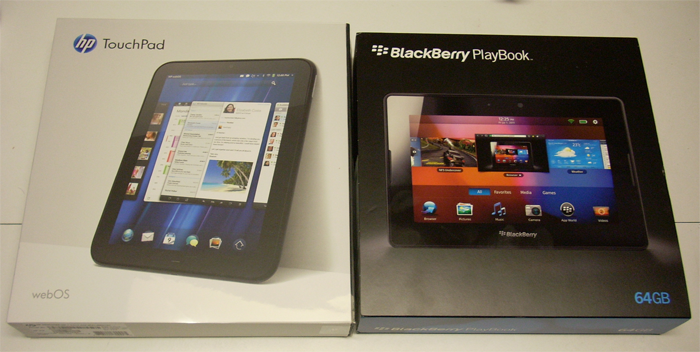




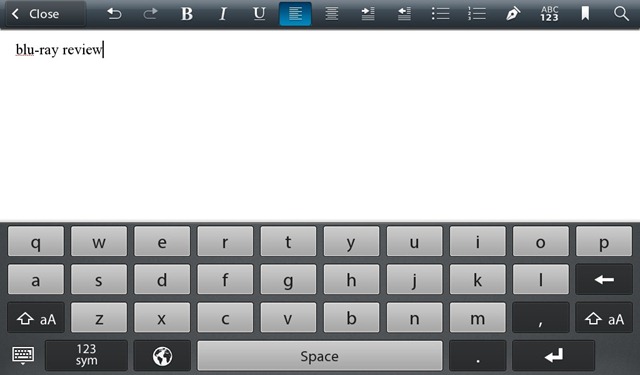
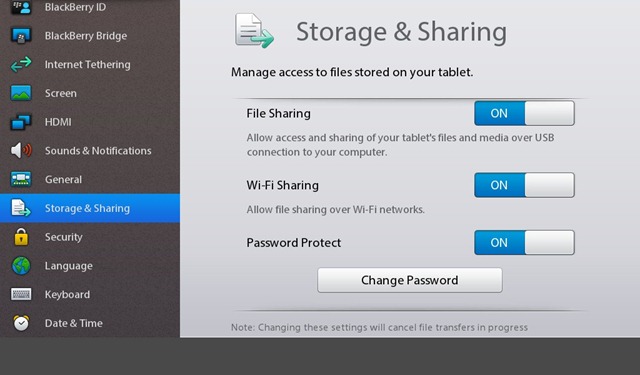

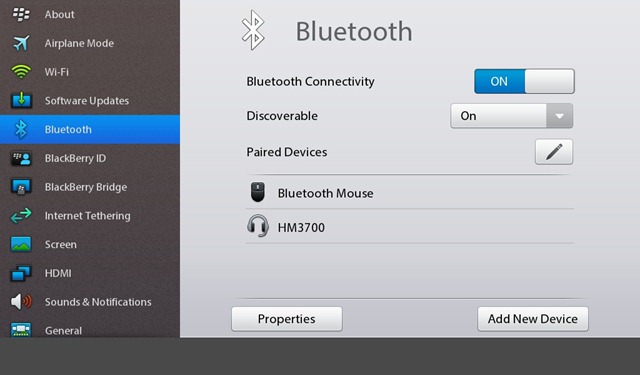

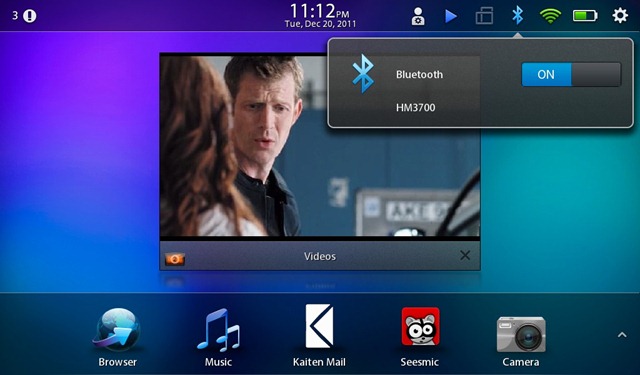
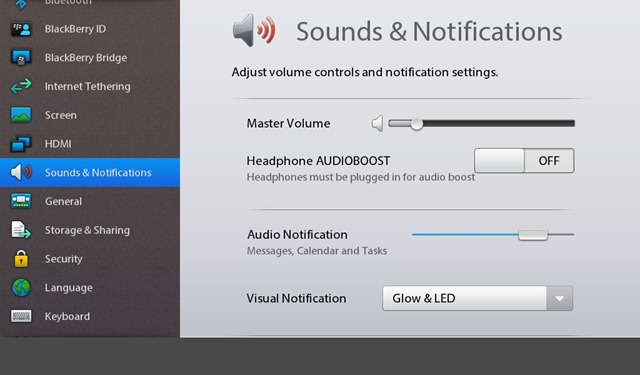

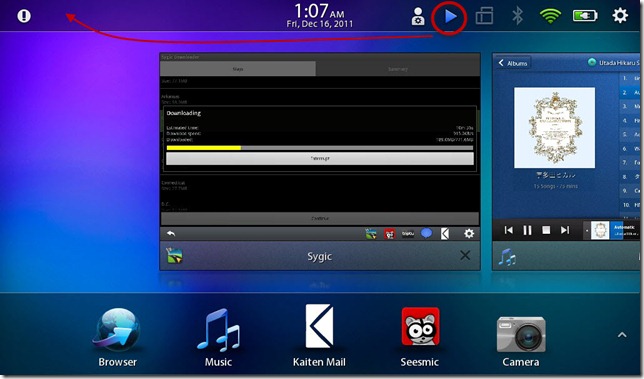
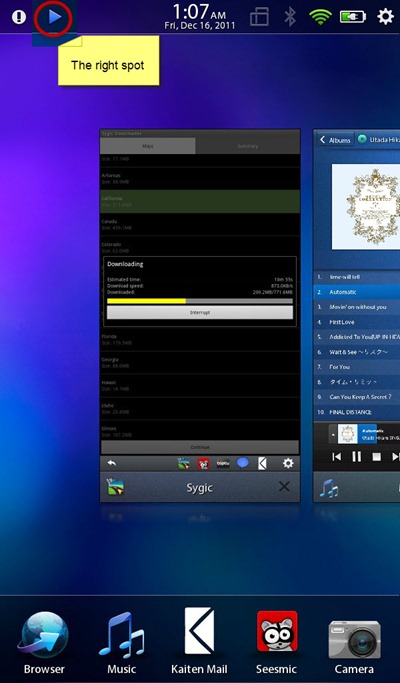
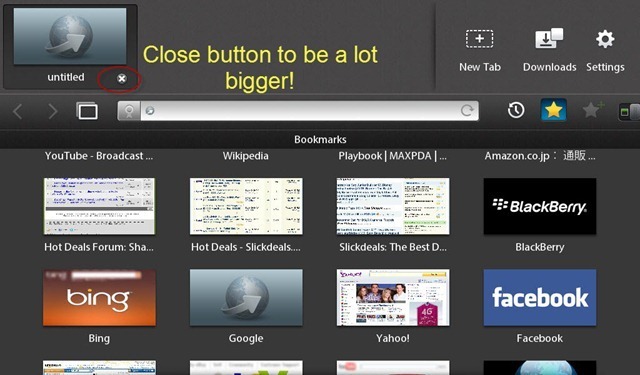
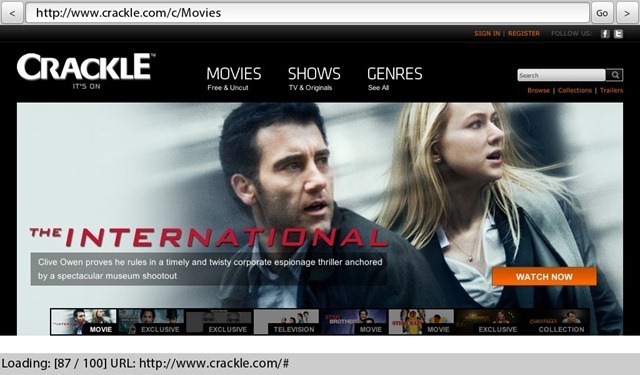
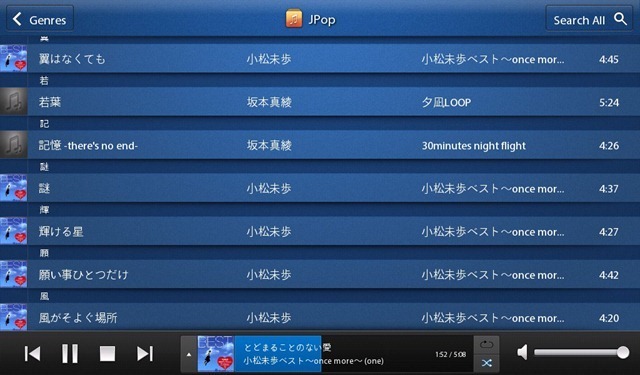
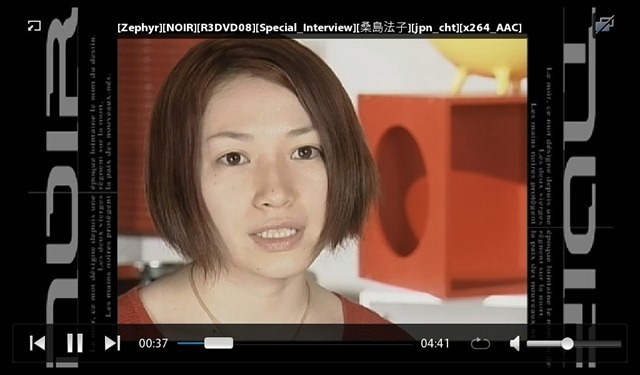
![BlackBerry PlayBook cam1_thumb[2]_thumb BlackBerry PlayBook cam1_thumb[2]_thumb](http://lh6.ggpht.com/-ADEjAwIl9pU/TvWy6tsOvNI/AAAAAAAAAiY/r5w10MyDqFk/BlackBerry%252520PlayBook%252520cam1_thumb%25255B2%25255D_thumb_thumb.jpg?imgmax=800)
![BlackBerry PlayBook cam2_thumb[2]_thumb BlackBerry PlayBook cam2_thumb[2]_thumb](http://lh5.ggpht.com/-Jf262xNNuE4/TvWy8M_Tf9I/AAAAAAAAAio/bNmhT0Z0m34/BlackBerry%252520PlayBook%252520cam2_thumb%25255B2%25255D_thumb_thumb.jpg?imgmax=800)
![BlackBerry PlayBook clock_thumb[2]_thumb BlackBerry PlayBook clock_thumb[2]_thumb](http://lh3.ggpht.com/-cTEVSJtp3fM/TvWy9x7ymyI/AAAAAAAAAi4/nfETwwpvG3A/BlackBerry%252520PlayBook%252520clock_thumb%25255B2%25255D_thumb_thumb.jpg?imgmax=800)
![BlackBerry PlayBook calculator_thumb[2]_thumb BlackBerry PlayBook calculator_thumb[2]_thumb](http://lh3.ggpht.com/-85sGBtlsSqE/TvWy_e30v3I/AAAAAAAAAjI/H_h74qrFl8E/BlackBerry%252520PlayBook%252520calculator_thumb%25255B2%25255D_thumb_thumb.jpg?imgmax=800)
![BlackBerry PlayBook email notification 4869_thumb[2]_thumb BlackBerry PlayBook email notification 4869_thumb[2]_thumb](http://lh5.ggpht.com/-TsEN--ldIyA/TvWzAohVQWI/AAAAAAAAAjY/Lf3WtXllFZQ/BlackBerry%252520PlayBook%252520email%252520notification%2525204869_thumb%25255B2%25255D_thumb_thumb.jpg?imgmax=800)
![BlackBerry PlayBook email notification 6149_thumb[2]_thumb BlackBerry PlayBook email notification 6149_thumb[2]_thumb](http://lh5.ggpht.com/-PrnGkoVY-Lc/TvWzCN6_MCI/AAAAAAAAAjo/FY-GGoy_yHU/BlackBerry%252520PlayBook%252520email%252520notification%2525206149_thumb%25255B2%25255D_thumb_thumb.jpg?imgmax=800)
![IMG_00000018_thumb[2]_thumb IMG_00000018_thumb[2]_thumb](http://lh4.ggpht.com/-knV0DPfmGvY/TvWzDW7pR4I/AAAAAAAAAj4/VTP1pgxo-f0/IMG_00000018_thumb%25255B2%25255D_thumb_thumb.jpg?imgmax=800)
No comments:
Post a Comment